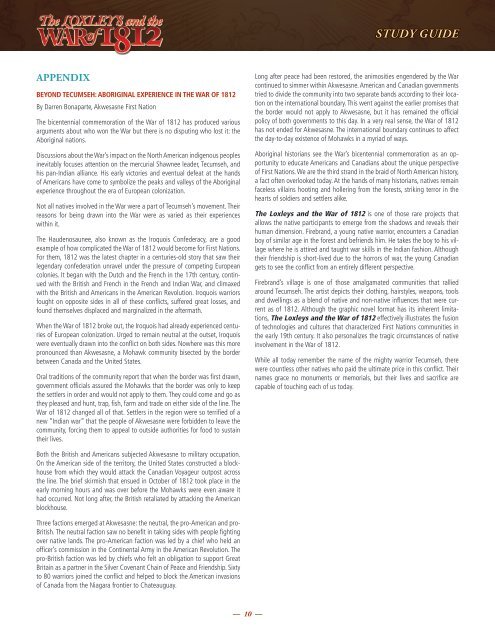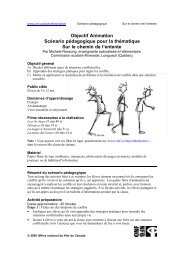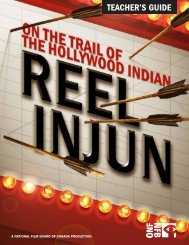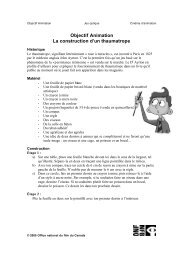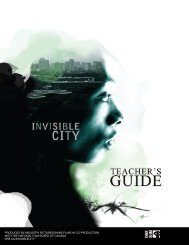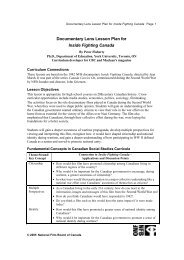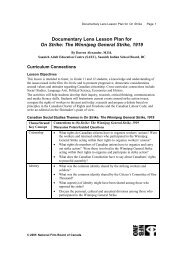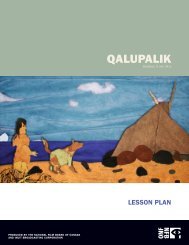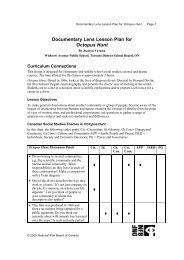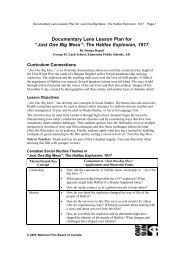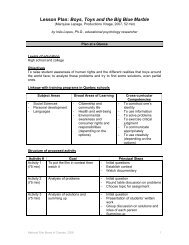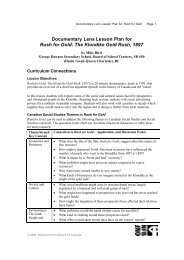Study guide - Office national du film du Canada
Study guide - Office national du film du Canada
Study guide - Office national du film du Canada
- No tags were found...
You also want an ePaper? Increase the reach of your titles
YUMPU automatically turns print PDFs into web optimized ePapers that Google loves.
STUDY GUIDEAPPENDIXBEYOND TECUMSEH: ABORIGINAL EXPERIENCE IN THE WAR OF 1812By Darren Bonaparte, Akwesasne First NationThe bicentennial commemoration of the War of 1812 has pro<strong>du</strong>ced variousarguments about who won the War but there is no disputing who lost it: theAboriginal nations.Discussions about the War’s impact on the North American indigenous peoplesinevitably focuses attention on the mercurial Shawnee leader, Tecumseh, andhis pan-Indian alliance. His early victories and eventual defeat at the handsof Americans have come to symbolize the peaks and valleys of the Aboriginalexperience throughout the era of European colonization.Not all natives involved in the War were a part of Tecumseh’s movement. Theirreasons for being drawn into the War were as varied as their experienceswithin it.The Haudenosaunee, also known as the Iroquois Confederacy, are a goodexample of how complicated the War of 1812 would become for First Nations.For them, 1812 was the latest chapter in a centuries-old story that saw theirlegendary confederation unravel under the pressure of competing Europeancolonies. It began with the Dutch and the French in the 17th century, continuedwith the British and French in the French and Indian War, and climaxedwith the British and Americans in the American Revolution. Iroquois warriorsfought on opposite sides in all of these conflicts, suffered great losses, andfound themselves displaced and marginalized in the aftermath.When the War of 1812 broke out, the Iroquois had already experienced centuriesof European colonization. Urged to remain neutral at the outset, Iroquoiswere eventually drawn into the conflict on both sides. Nowhere was this morepronounced than Akwesasne, a Mohawk community bisected by the borderbetween <strong>Canada</strong> and the United States.Oral traditions of the community report that when the border was first drawn,government officials assured the Mohawks that the border was only to keepthe settlers in order and would not apply to them. They could come and go asthey pleased and hunt, trap, fish, farm and trade on either side of the line. TheWar of 1812 changed all of that. Settlers in the region were so terrified of anew “Indian war” that the people of Akwesasne were forbidden to leave thecommunity, forcing them to appeal to outside authorities for food to sustaintheir lives.Long after peace had been restored, the animosities engendered by the Warcontinued to simmer within Akwesasne. American and Canadian governmentstried to divide the community into two separate bands according to their locationon the inter<strong>national</strong> boundary. This went against the earlier promises thatthe border would not apply to Akwesasne, but it has remained the officialpolicy of both governments to this day. In a very real sense, the War of 1812has not ended for Akwesasne. The inter<strong>national</strong> boundary continues to affectthe day-to-day existence of Mohawks in a myriad of ways.Aboriginal historians see the War’s bicentennial commemoration as an opportunityto e<strong>du</strong>cate Americans and Canadians about the unique perspectiveof First Nations. We are the third strand in the braid of North American history,a fact often overlooked today. At the hands of many historians, natives remainfaceless villains hooting and hollering from the forests, striking terror in thehearts of soldiers and settlers alike.The Loxleys and the War of 1812 is one of those rare projects thatallows the native participants to emerge from the shadows and reveals theirhuman dimension. Firebrand, a young native warrior, encounters a Canadianboy of similar age in the forest and befriends him. He takes the boy to his villagewhere he is attired and taught war skills in the Indian fashion. Althoughtheir friendship is short-lived <strong>du</strong>e to the horrors of war, the young Canadiangets to see the conflict from an entirely different perspective.Firebrand’s village is one of those amalgamated communities that ralliedaround Tecumseh. The artist depicts their clothing, hairstyles, weapons, toolsand dwellings as a blend of native and non-native influences that were currentas of 1812. Although the graphic novel format has its inherent limitations,The Loxleys and the War of 1812 effectively illustrates the fusionof technologies and cultures that characterized First Nations communities inthe early 19th century. It also personalizes the tragic circumstances of nativeinvolvement in the War of 1812.While all today remember the name of the mighty warrior Tecumseh, therewere countless other natives who paid the ultimate price in this conflict. Theirnames grace no monuments or memorials, but their lives and sacrifice arecapable of touching each of us today.Both the British and Americans subjected Akwesasne to military occupation.On the American side of the territory, the United States constructed a blockhousefrom which they would attack the Canadian Voyageur outpost acrossthe line. The brief skirmish that ensued in October of 1812 took place in theearly morning hours and was over before the Mohawks were even aware ithad occurred. Not long after, the British retaliated by attacking the Americanblockhouse.Three factions emerged at Akwesasne: the neutral, the pro-American and pro-British. The neutral faction saw no benefit in taking sides with people fightingover native lands. The pro-American faction was led by a chief who held anofficer’s commission in the Continental Army in the American Revolution. Thepro-British faction was led by chiefs who felt an obligation to support GreatBritain as a partner in the Silver Covenant Chain of Peace and Friendship. Sixtyto 80 warriors joined the conflict and helped to block the American invasionsof <strong>Canada</strong> from the Niagara frontier to Chateauguay.— 10 —


